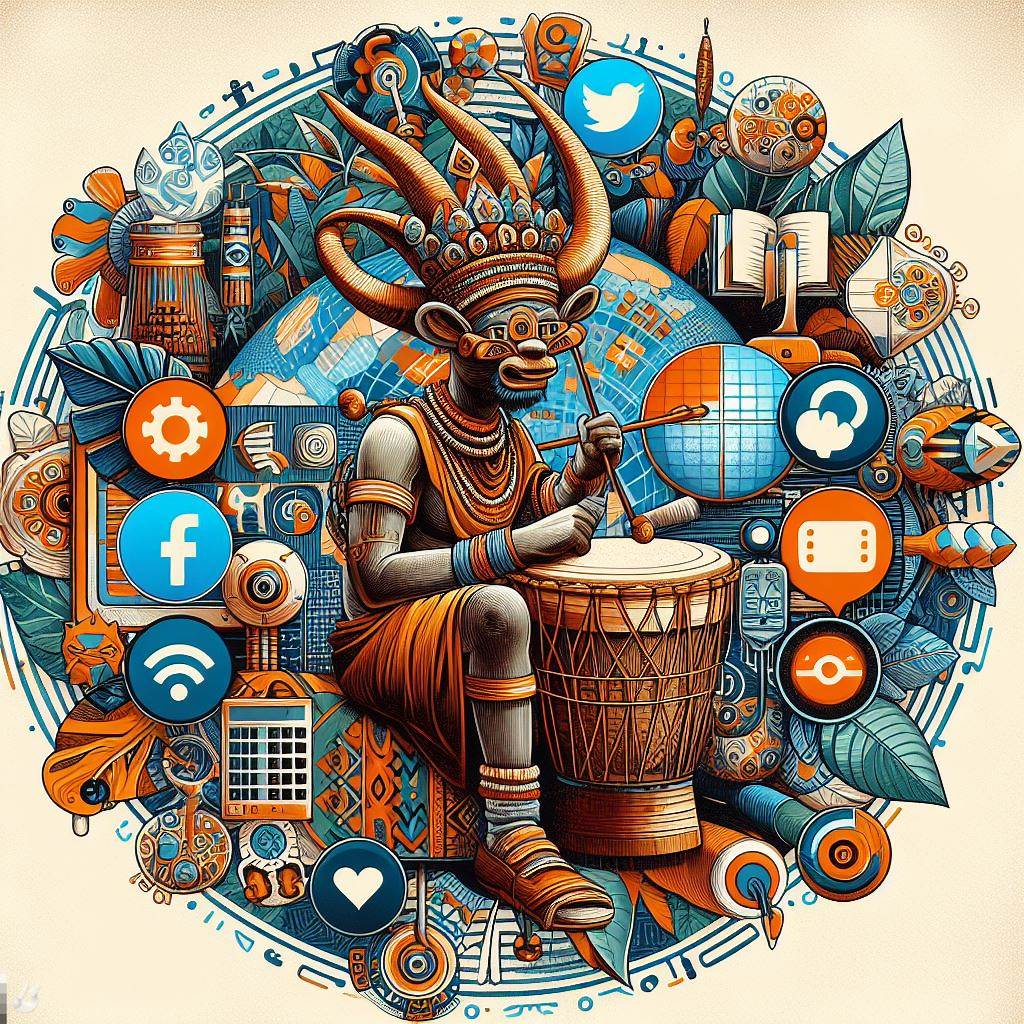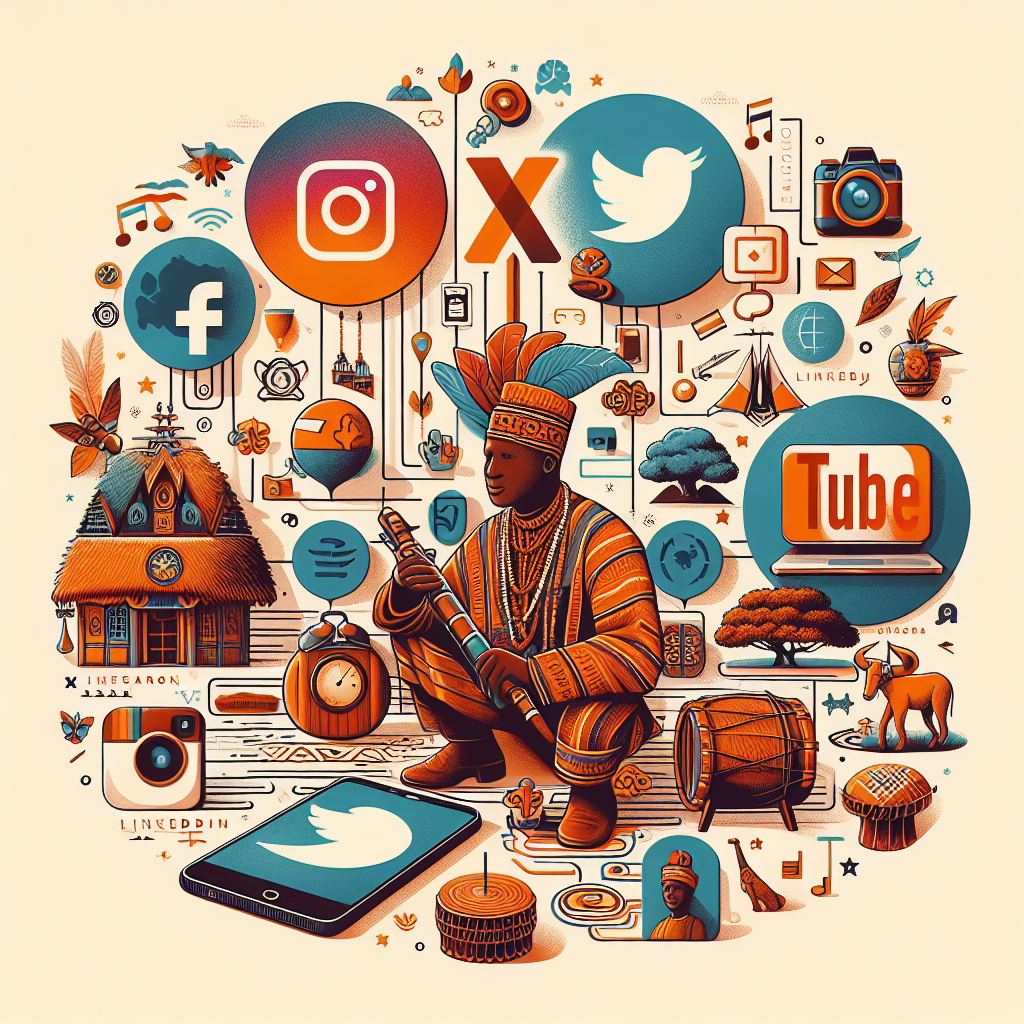Executive Summary
This report explores the role of social media in the preservation and promotion of cultural traditions in Cameroon. The paragraph discusses the cultural heritage, challenges in preservation, and social media opportunities. Case studies include masquerades (Juju), Fon of Mankon’s enthronement, Fon of Nso’s visit to Germany, and Bamoun King’s enthronement. Social media’s impact on cultural practices and its role in shaping identity are examined. The report concludes with recommendations on effectively and responsibly using social media to foster cultural diversity and harmony in Cameroon.
Definition of Key Terms
1. Social Media
Social media refers to a collection of online platforms and tools that allow users to create, share, and exchange content and participate in social networking. Examples include Facebook, Twitter, Instagram, YouTube, and TikTok.
2. Cultural Traditions
People pass down customs, practices, beliefs, values, and artefacts from one generation to another within a specific culture or community, forming cultural traditions. These traditions have a substantial impact on shaping cultural identity and are typically based on historical, social, and religious backgrounds.
3. Cultural Appropriation
Cultural appropriation is the adoption or borrowing of elements from one culture by members of another culture, often without understanding or respecting the cultural significance behind those elements. It can involve the use of clothing, hairstyles, music, language, symbols, or other cultural expressions.
4. Cultural Identity
Cultural identity refers to an individual’s sense of belonging and identification with a particular culture or cultural group. It encompasses the customs, traditions, beliefs, values, and practices that shape a person’s understanding of who they are within a cultural context.
Introduction
Social media is a powerful tool for communication, entertainment, education, and activism. But it also affects the preservation and promotion of cultural traditions, especially in Cameroon. This report examines how to use social media to preserve and celebrate Cameroon’s diverse and vibrant culture. It addresses the challenges and opportunities of this approach. Also, it examines how Cameroonians use social media to share their cultural practices, such as languages, rituals, ceremonies, music, dance, and masquerades. Finally, this report discusses how social media influences the expression and representation of cultural identity in the context of the Anglophone conflict. Recommendations on using social media effectively and responsibly to foster cultural diversity and harmony in Cameroon are provided in the end.
Background
Cameroon is home to approximately 250 ethnic groups that form five regional/cultural groups: western highlanders, coastal tropical forest people, southern tropical forest people, Muslims of the northern semi-arid regions and central highlands, and the Kirdi. Each group has its own language, religion, customs, and history. Cameroon also has two official languages, English and French, which are a legacy of its colonial past. However, many Cameroonians speak neither of these languages, but rather use Pidgin English, as a lingua franca.
Social media can offer a way for Cameroonians to document and share their cultural practices, such as languages, rituals, ceremonies, music, dance, and masquerades. For example, some young Cameroonians are using platforms like Facebook, Twitter and YouTube to promote and teach their native languages, such as Mankon, Ngemba and Limbum
Case Studies
Case Study 1
Preserving the Sacred Essence of Masquerades (Juju) in the Digital Age
Masquerades (Juju) have long been an integral part of Cameroon’s cultural heritage, representing the embodiment of supernatural beings and serving as agents of social control, justice, medicine, and entertainment. However, in recent times, the traditional practice of Juju has faced challenges as some performers deviate from cultural norms and engage in activities that are disrespectful, immoral, and profane. This case study explores the impact of social media on the preservation and promotion of the sacred traditions of Masquerades (Juju) and proposes strategies to address the issue. For example, are Juju taking selfies with the military during an unstable socio-political climate in the region. Similar activities are; Juju boards a bike, Juju accompanies priests in church, Juju slizing Okra to cook. In the previous months what broke the internet was a video of Tzy Panchaack where he used a masquerade in his music video.
Role of Social Media in the Preservation and Promotion of Masquerades (Juju)
Social media enables global showcasing of cultural practices, but modernization, urbanization, globalization, and media exposure erode traditional values. Some young Masquerade (Juju) participants deviate from authentic practices and misunderstand their cultural significance.
Consequences of Deviation and Loss of Cultural Identity
The consequences of this deviation are significant, including loss of cultural identity, authenticity, diversity, and harmony among different generations and groups. Erosion of traditional values may undermine faith in Masquerades (Juju) as problem-solving or protective practices. Violations of Juju’s rules may result in sanctions or punishments from elders or authorities.
Preserving and Promoting Cultural Heritage through Education and Accountability
To address these challenges, educating and sensitizing young people about the history, meaning, and significance of Masquerades (Juju) is crucial. Deep understanding can foster responsibility and appreciation for cultural heritage.
Leaders and elders of Masquerade (Juju) societies enforce discipline, accountability, and ethical standards. They maintain authenticity and integrity by upholding the sacred essence and contextualizing performances.
Blending Social Media and Cultural Preservation
When sharing Masquerades (Juju) on social media, it’s important to provide cultural context and educational captions. This promotes understanding and avoids trivialization or misrepresentation, preserving and appreciating the tradition.
Conclusion
Preserving Masquerades (Juju) requires collective efforts from the community, leaders, and social media users. Education, accountability, and responsible sharing can safeguard cultural heritage, maintain identity, and foster generational harmony in Cameroon.
Case Study 2
Balancing Tradition and Modernity: The Enthronement of the Fon of Mankon
The enthronement of the Fon of Mankon, one of the largest and oldest kingdoms in Cameroon’s Northwest Region, is a significant cultural celebration that represents the transition of leadership and the preservation of traditions. Social dynamics and social media pose challenges to tradition. This case study examines social media’s impact on enthronement and suggests strategies for leveraging digital platforms positively.
The Evolving Enthronement Process
Traditionally, the enthronement of the Fon of Mankon was a secretive and exclusive ceremony, accessible only to the initiated. However, in recent years, the process has transformed to increase public awareness and participation, particularly among Mankon sons and daughters living in different locations and backgrounds. The aim is to showcase the cultural heritage, diversity, and richness of the Mankon fondom. The enthronement process is usually initiated after the “disappearance” of the previous Fon, which the Kwifor announces after a period of mourning and secrecy.
Role of Social Media in Enthronement
Social media transformed the perception and experience of the enthronement process. It disseminated information, engaged Mankon residents and people worldwide, and fostered inclusivity through real-time updates, photos, and videos on platforms like Facebook, Instagram, and Twitter.
Challenges and Opportunities
Social media promotes culture but challenges the sacredness of the enthronement process. Balancing tradition and modernity requires adaptation. Preserving Mankon’s core values while embracing social media’s potential for positive change is crucial.
Adapting Practices for Modern Trends
To respond to the changing circumstances and challenges, it is crucial to modify practices to align with current trends while preserving the essence of tradition. Leveraging social media educates and inspires younger generations about the enthronement process, fostering cultural appreciation. Sharing Mankon tradition globally instils pride, wisdom, and beauty in both the community and spectators.
Ethical and Responsible Social Media Usage
As social media continues to shape cultural celebrations, it is important to maintain ethical and responsible practices. Sensitivity should be exercised in sharing content related to the enthronement process, ensuring that the sacredness of the ceremony is preserved and respected. By embracing responsible social media usage, the Mankon fondom can strive for cultural preservation, inclusivity, and global understanding.
Conclusion
The Fon of Mankon’s enthronement symbolizes tradition, leadership, and cultural heritage. Embracing social media is crucial for relevance and engaging the younger generation. Balancing tradition and modernity through adaptation, leveraging social media, and promoting responsible usage preserves cultural identity in the digital age.
Case Study 3
Reuniting Ngonnso: The Fon of Nso’s Visit to Germany
The story of Ngonnso, the stolen wooden statue of the Nso people, represents the enduring struggle of many African nations to reclaim their cultural heritage from the colonial era. After over a century of demanding the return of Ngonnso and other looted artefacts, the Fon of Nso embarked on a historic visit to Germany in 2022 to reconnect with the symbolic mother goddess of his people. This case study explores the role of social media in advocating for the restitution process and highlights the significance of Fon’s visit in reaffirming cultural identity and unity.
The Power of Social Media
Social media played a pivotal role in raising awareness and mobilizing support for the return of Ngonnso. Through persistent campaigns, including those led by Sysy House of Fame, pressure was exerted on the German government to acknowledge the colonial legacy and address the issue of stolen cultural artefacts. The online platforms provided a space for sharing information, garnering international attention, and maintaining the momentum necessary for successful negotiations.
The Restitution Journey
In response to pressure, Germany committed to restitution and returning Ngonnso. The Humboldt Forum agreed to facilitate the process and prepare Ngonnso for her journey home, rectifying past injustices and honouring Nso cultural heritage.
The Fon’s Visit and Reconnection
In November 2022, the Fon of Nso travelled to Germany for a historic meeting with Ngonnso at the Humboldt Forum. The Fon’s visit, accompanied by dignitaries and journalists, symbolized the reconnection between the sacred statue and its people. Rituals reaffirmed Nso cultural heritage, identity, and unity. The Fon respected Ngonnso’s sacredness and refrained from touching her, knowing additional rituals were needed.
Preserving Authenticity and Embracing the Changing World
The Fon’s visit demonstrated the ability of a traditional institution to preserve its authenticity while embracing innovation and transformation. Using social media, the Nso people advocated for restitution, preserving cultural integrity and engaging a global audience. The event demonstrated social media’s power in documenting and sharing inaccessible cultural moments.
Conclusion
The Fon of Nso’s visit to Germany marked a milestone in Ngonnso’s restitution and showcased social media’s power in cultural heritage advocacy. Online campaigns pressured the German government to commit to the artefact’s return. The visit reaffirmed Nso’s cultural identity and unity while emphasizing responsible engagement with sacred traditions in the digital age. Ngonnso’s story highlights the importance of preserving and reclaiming cultural heritage, amplified by social media.
The meeting reaffirmed and reinforced the cultural heritage, identity, and unity of the Nso people. It was also a milestone in the restitution process that will eventually bring Ngonnso back to Cameroon. The meeting exemplified how a traditional institution balances authenticity, integrity, and innovation in a changing world.
Before social media, such events went undocumented and remained largely unknown. Ngonnso is a secret statue that isn’t supposed to be seen by women. The Fon did not touch Ngonnso during the ritual ceremony because to do so further rituals needed to be done.
Case Study 4
Celebrating Tradition: Social Media’s Impact on the Enthronement of the Bamoun King
Sultan Nabil Mbombo Njoya’s enthronement as the 20th king of the Bamoun kingdom was a historic moment. With his youth and academic achievements, the event on October 10, 2021, gained attention and admiration in Cameroon and on social media. This case study examines social media’s role in spreading news, celebrating cultural heritage, and engaging a global audience in the Bamoun kingdom’s enthronement.
Social Media’s Amplification of Cultural Celebrations
Social media platforms have played a crucial role in disseminating news and generating excitement about the Bamoun kingdom’s enthronement. Users from diverse backgrounds have taken to platforms such as Twitter, Facebook, and Instagram to express their congratulations and support for Sultan Nabil Mbombo Njoya. Some notable comments on social media include those from MsBJPeart, Obianyanwu Valentine, and St. John’s University. This digital celebration has created a sense of unity, connecting individuals within and outside Cameroon who share an appreciation for cultural heritage.
Promoting Cultural Heritage
Social media promotes and showcases the rich cultural heritage of the Bamoun people through the enthronement ceremony. Users share images, videos, and stories, allowing a global audience to witness and appreciate traditions, customs, and regalia. This digital promotion fosters pride, understanding, and awareness of the Bamoun community’s cultural heritage.
Engaging a Global Audience
Social media enables global engagement with the Bamoun kingdom’s enthronement, fostering fascination, curiosity, and admiration for its cultural significance. Cross-cultural connections and conversations strengthen cultural diplomacy, promoting understanding and appreciation of diverse traditions.
Digital Documentation and Preservation
Social media’s ability to capture and share real-time content has facilitated the documentation and preservation of the enthronement ceremony. Photos, videos, and personal narratives shared on platforms serve as digital archives, ensuring that this significant cultural event is recorded and accessible for future generations. The digital footprint allows for the continued celebration and remembrance of the enthronement, even after the ceremony has concluded.
Conclusion
Sultan Nabil Mbombo Njoya’s enthronement showcases social media’s power in celebrating and promoting cultural heritage. Platforms like Twitter, Facebook, and Instagram engage a global audience, fostering appreciation and understanding of Bamoun traditions. Social media documents and preserves the event, ensuring its remembrance. As social media evolves, it enriches our global understanding of diverse traditions, offering opportunities for cultural preservation and cross-cultural connections.

Recommendations
1. Education and Sensitization
It is crucial to educate and sensitize young people about the history, meaning, and significance of cultural traditions to foster a deeper appreciation and understanding of their cultural heritage.
2. Community Engagement
Encouraging active participation and involvement of community members in cultural preservation efforts can help ensure the continuity and vitality of cultural traditions.
3. Responsible Use of Social Media
When sharing content on social media, users should be mindful of cultural sensitivity and appropriateness, especially when it involves sacred or secret cultural practices.
4. Collaboration and Dialogue
Promoting a better understanding of cultural traditions and fostering respectful engagement can be achieved by creating platforms for dialogue and collaboration between traditional leaders, cultural custodians, and social media influencers. These platforms facilitate meaningful interactions and exchanges of knowledge.
5. Ethical Guidelines
Developing and promoting ethical guidelines for the representation and portrayal of cultural traditions on social media is essential. These guidelines can help prevent cultural appropriation and ensure responsible and respectful engagement.
Author: Ngufack Ntemgwa

